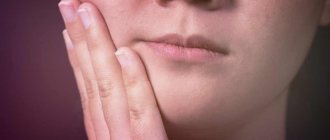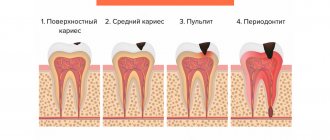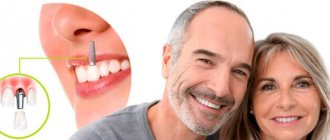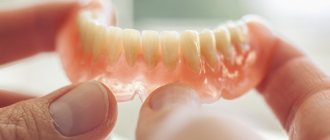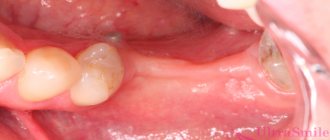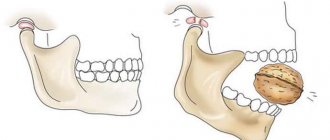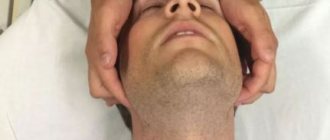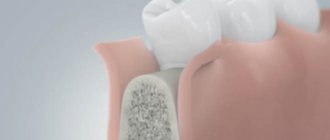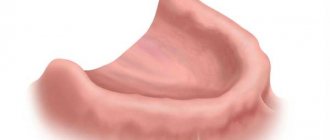1314
Installing a splint is a traditional way to combat temporomandibular joint dysfunction.
Recently, the technology has been improved, and special mechanisms for joints began to be used.
One of the most effective devices aimed at eliminating pathologies is the TMJ splint.
General information and purpose
The TMJ splint is a device with a rigid structure, removable and fixed, and takes the shape of the jaw under the influence of temperature. Fixed on the jaw.
The design is intended for use in the oral cavity of patients over eighteen years of age. The bus is modeled using digital systems and is therefore delivered with pre-programmed properties.
Experts highly value the effectiveness of the device, since corrective measures with its help can begin after the first inspection.
Design Features
The TMJ design used in orthodontics refers to two-jaw systems and has a horseshoe shape. Made from high-tech silicone materials , characterized by elastic and elastic properties.
The tire is resistant to chemically active substances , resistant to mechanical stress, and durable.
The trainer part is adjusted to the specific characteristics of the jaw. Sizing selection is a very important point. The patient's comfort depends on this.
Along the inner edges of the structure there are special stops that provide reliable fastening, preventing tongue biting.
The elements of the device are designed in such a way that the load is reduced, ensuring the relaxation of muscle ligaments.
A distinctive feature of the TMJ splint is the ability to adapt to the jaw structure of a particular patient, eliminating allergic reactions and discomfort during use.
The dentist selects the device during the initial examination. With the right choice, reliable fixation on the jaw is ensured, and there are no violations of diction.
The transparent materials used in production make it possible to hide the use of the structure.
Features of therapy with disconnecting mouthguards for hypertension of the masticatory muscles.
Come here to find out how an anti-snoring mouth guard works.
At this address https://zubovv.ru/ortodontiya/treyneryi/mogut-li-zamenit-brekety.html read about the effectiveness of orthodontic trainers for children.
What is a joint splint
They belong to trainers; silicone or elastic polyurethane are used for their manufacture. The design has the shape of a U-shaped arc, the dimensions are selected individually. It is very important to choose the correct size at your first visit, as this has a strong impact on wearing comfort.
The design of the tire has a special tongue stop on the sides, which allows you to control its position. Protection against tongue biting is provided by a small front tongue.
Kinds
The splints used for treatment are divided into the following types:
- single-jaw, that is, used to correct only one jaw;
- double-jawed, used for the treatment of bruxism, with pathological trauma to the enamel layer.
During treatment, the splint is placed between the jaws, controlling their position and modeling the bite. The elasticity of the material reduces stress on the surface of the teeth, reduces friction and reduces the overall load on joints and muscles. Shock-absorbing properties can reduce the symptoms of arthrosis and get rid of phenomena such as mouth breathing and bruxism.
Treatment with a splint involves its use for at least one hour during the day, the total duration is from 1-6 months, depending on the pathology. The direction of correction and duration of treatment is determined only by the dentist; you cannot interrupt wearing the splint yourself. To improve the effect, physiotherapeutic procedures, ointments or tablets may be prescribed.
Tires are available in various types, the most popular being low-slung all-day tires. They fit very tightly to the dentition and do not interfere with normal speech articulation at all. The silicone is transparent, almost invisible, and comfortable to wear. There are models that must be immersed in hot water before use. This way they adhere better to the surface of the teeth and provide greater effect.
Rules of care
| Click to sign up for a FREE consultation |
The structure requires careful care, for which it must be removed and washed with a toothbrush and regular toothpaste. The paste can be replaced with a special solution; the tire must be stored in a special container, which preserves its transparency, flexibility and extends its service life.
It is also necessary to take into account that during routine visits to the doctor, a small grinding of all protruding parts may be required, according to the bite. In some cases, instead of sanding, additional layers are applied if the dentist deems it necessary.
Indications and restrictions
Disorders of the temporomandibular joint have a very serious impact on human life. This is expressed in the appearance of pain, difficulties in chewing food, diction, etc.
The following factors lead to such symptoms:
- Malocclusion;
- Surgical intervention, the consequence of which was disruption of the functioning of the temporal mandibular joint;
- Trauma to the jaw bones;
- Infection;
- Stress;
- Improper breathing;
- Deviations received at birth;
- Excessive abrasion of enamel and dentin;
- Great pressure on teeth;
- The presence in the diet of a large number of dishes from hard ingredients.
About a third of patients with orthodontic deviations suffer from TMJ defects. The very first treatment method is a TMJ splint.
TMJ modification is prescribed in the following cases:
- Clicking sounds when opening and closing the mouth;
- Bruxism;
- Myofunctional disorders;
- Problems with jaw movement due to injury.
Contraindications for use are as follows:
- Diseases of the central nervous system;
- Tumors in the mouth;
- Serious deviations in the anatomical structure of the jaws.
What is TMJ dysfunction?
The statistics on the occurrence of the disease are impressive - from 11 to 45% of the population have ever encountered this joint problem. Pathology caused by occlusal, muscular, and spatial problems. In other words, the joint connecting the lower and upper jaws does not work correctly and requires treatment. Ignoring the treatment of such malocclusion can lead to the development of severe pain, as well as arthrosis of the joint.
Why do patients experience TMJ dysfunction?
Pathology, first of all, arises against the background of problematic functioning of the complex (hinge-shaped) joint connecting the upper and lower jaws.
There can be several causes of TMJ pathology:
- malocclusion;
- constant stiffness of the facial muscles as a result of neuropsychic or physical stress;
- absence of a chewing tooth or several units of chewing groups in the mouth;
- tendency to increased tooth wear;
- mechanical injury;
- poor-quality installation of prostheses;
- problems with the spine (for example, scoliosis);
- the habit of chewing on one side, thereby loading the TMJ;
- birth injuries;
- mistakes when installing fillings and treatment in the past;
- incorrectly selected orthodontic treatment in the past;
- anatomically incorrect structure of the joint (for example, when the shape and size of the articular head and the articular fossa of the TMJ do not correspond to each other).
How does TMJ dysfunction manifest?
Manifestations of the disease cannot be ignored:
- Clicking sounds when opening the mouth and when at rest. The sound can be heard not only by the person with the problem, but also by those around him. In this case, the joint itself may not hurt. The clicks are especially audible when yawning and opening the mouth wide;
- Blocking or “jamming” of the TMJ. A problem that occurs when the mouth opens suddenly. To open the mouth wide enough, a person needs to adapt to the position of the joint, as if to “catch” it. Also, when jammed, the jaws do not “unclench”, but after such precedents they begin to close and open differently;
- Pain. It can be projected not only in the area of the joint, but also in the neck, entire mouth, back, shoulder and even arm. The pain occurs either suddenly or with prolonged chewing, often disturbing at night.
Also, in the absence of long-term treatment for disorders of the TMJ, the patient may experience headaches, dizziness, weakness, pressing sensations behind the eyes, squeaking in the ears, sleep disturbances, increased nervousness, etc.
When treatment is not provided, long-term degenerative processes occur:
- Firstly, the intra-articular disc is constantly subject to dislocation;
- Secondly, over time the disk changes its shape and wears out;
- Third, the ligament that holds the disc in place becomes thinner over time and can tear.
How can you tell if a person is suffering from TMJ dysfunction?
The listed symptoms are a clear sign that something is wrong with the joint and require mandatory comprehensive treatment. Even in the early stages of the development of the disease, a person does not feel any deviation from the norm, his jaw begins to behave differently, and the pain in the mouth intensifies over time.
To confirm the diagnosis, the dentist must:
- carry out a visual examination of the teeth and oral cavity as a whole;
- collect anamnesis and study the patient’s complaints;
- perform an ocludogram to study the position of the jaws in relation to each other;
- refer the person for orthopantomography, x-ray and computed tomography of the TMJ. An MRI may be needed to monitor and correct treatment.
In some cases, additional consultation with related specialists is required: neurologist, rheumatologist, ENT specialist, etc.
Based on the diagnostic procedures performed, the patient is diagnosed and step-by-step treatment is prescribed.
It is important! To effectively treat the disease, you need to contact an experienced dentist, who will not only diagnose the condition of the oral cavity, but will be able to distinguish a violation of the structure and functions of the TMJ from other pathologies. For example, from jaw dislocation, articular arthrosis, complex diseases, arthritis, synovitis, etc.
This is interesting: Is it possible to straighten teeth with crowns - an effective method of correcting a bite
Prevention of TMJ dysfunction
Common tactics for treating TMJ dysfunction involve the following ways:
- Drug therapy to eliminate pain. At this stage, the patient may be recommended to take a course of muscle relaxants, antidepressants, or glucocorticosteroid drugs. It is possible that during the treatment process, injections of botulinum toxin into the jaw projection will be necessary to reduce muscle spasm and alleviate the patient’s general condition.
- To functionally relax the jaw muscles, a course of psychotherapeutic assistance may be necessary. Physiotherapeutic procedures in the joint projection are also relevant, including electrophoresis, laser therapy, ultrasound, etc. Also at this stage of treatment, special relaxation exercises are recommended to control the condition of the muscles.
- Orthodontic care. This involves correcting the bite using braces or aligners. In some clinical cases, the patient is recommended to wear mouth guards, splints, orthodontic plates, etc. Wearing a special orthodontic bite splint will reduce the adverse effect of teeth grinding. Repeated prosthetics, implantation or filling of teeth may be necessary.
- Surgery is indicated in the absence of the desired effect in the case of using the above treatment methods, including after wearing orthodontic appliances. At this stage, myotomy of the pterygoid muscle, arthroplasty, and condylotomy of the head of the mandible can be performed.
What to do to prevent the primary or secondary development of joint dysfunction?
- Have regular dental checkups (at least twice a year);
- take care of your teeth and oral cavity;
- reduce excess loads;
- do not expose the body to stress and anxiety;
- treat caries, pulpitis and gum diseases in a timely manner;
- wear orthodontic systems when indicated for bite correction;
- perform implantation and installation of dentures by experienced doctors;
- correct orthopedic problems in a timely manner;
- treat factors that increase the risk of joint dysfunction (bruxism, neurological diseases, etc.).
Where to go for treatment for TMJ dysfunction?
As dental practice shows, in recent years the problem of TMJ dysfunction has become more widespread. Adequate treatment of pathology is possible only with an accurate determination of the causes, comprehensive diagnosis and a qualified approach. Such help can be obtained at a dental clinic. The clinic's doctors specialize in the treatment of TMJ dysfunction, even in the most complex cases. Make an appointment with your dentist to solve the problem once and for all and gain a beautiful and healthy smile.
What happens if TMJ dysfunction is not treated?
If the dysfunction is not treated, the compensatory capabilities of the body may sooner or later be exhausted, the symptoms will worsen, the pathology will begin to progress, causing greater discomfort (sometimes for several years), thereby affecting the deterioration of the function of the dental system.
In order to try to prevent this and carry out treatment taking into account the individual characteristics of the structure and functioning of the temporomandibular joints, patients are usually offered the following approach.
Operating principle, wearing order
The base of the splint is made in the shape of a wing, which makes it possible to relax muscle ligaments. This design reliably fixes the jaws and corrects any defects that have arisen.
The device does not cause any inconvenience when used and almost immediately takes the shape of the patient’s jaw. Preliminary and preparatory measures are also not required.
Thus, standard factory products can be used. This is achieved due to the fact that the design itself adapts to the structural features of the joint.
Installing the device on the area of the jaw to be corrected takes no more than five minutes and is not difficult. The result is a design that matches the characteristics of the body, which allows you to correct existing defects .
Fixation of the device is carried out as follows:
- The structure is lowered into heated water for several minutes;
- After the required time interval has passed, when the elements soften under the influence of temperature, it is pulled out and left to cool for ten seconds;
- Installation is carried out in an area that requires correction. Due to the design features, a tight fit of the TMJ tire is created;
- The patient needs to clench his jaw tightly for half a minute and inhale through his nose; there should be no air in the oral cavity;
- Next, the device is removed and completely cooled, after which it is ready for use.
The structure can be adjusted no more than once.
The splint is used during the day and removed at night. Doesn't interfere with doing housework, reading, or working on a PC. In this case, there is no violation of diction.
Objective reviews of Invisalign aligners and their purpose in orthodontics.
In this publication we will talk about the rules for using the T4k pre-orthodontic trainer.
Here https://zubovv.ru/ortodontiya/treyneryi/vsya-podrobnaya-informatsiya-pro-t4a.html you will find all the most important things about the T4a orthodontic trainer.
Expected effect
The tangible result appears after a few days. The duration of treatment depends on the degree of the defect, and can last from thirty days to six months.
The design is aimed at eliminating the causes of pain in the cervical region and head.
From the first day of wearing you can:
- Reduce pain and other signs of the disease;
- Remove pressure on the joint;
- Reduce teeth grinding;
- It is possible to eliminate dysfunction of the joints;
- Correct asymmetry;
- Eliminate mouth breathing;
- Stabilize pressure on teeth during sports training.
In addition, it is possible to diagnose pathologies that cause pain in the cervical and head regions.
The video provides additional information on the topic of the article.
Reviews
Problems with the facial part of the head in the field of orthodontics are especially critical, since in addition to functional problems, defects affect the appearance and diction of the patient. Elimination of pathologies is very important for maintaining normal life activities.
Patients need as much information as possible to choose the right clinic and specialist. In this regard, we ask those who have personal experience of treatment to leave their feedback after the article.
If you find an error, please select a piece of text and press Ctrl+Enter.
Tags orthodontics trainers
Did you like the article? stay tuned
No comments yet
Indications for treatment
Wearing splints may be prescribed for the following symptoms:
- chronic, acute pain in the joint area;
- the appearance of crunching, clicking in the joint, which indicates the development of pathological processes;
- muscle trismus, difficulty chewing food;
- headaches that become migraine-like;
- bruxism, which causes increased abrasion of the enamel layer;
- the mouth stops opening completely, which is accompanied by pain.
